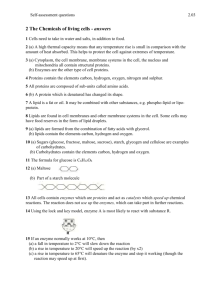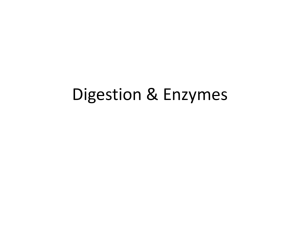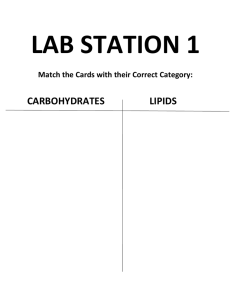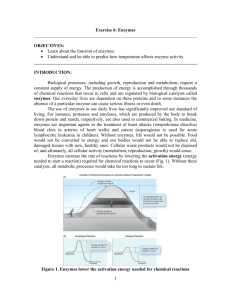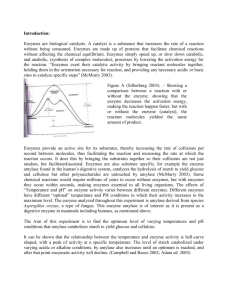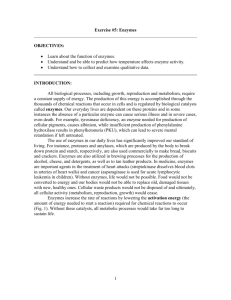Enzymes – The Necessary Special Protein
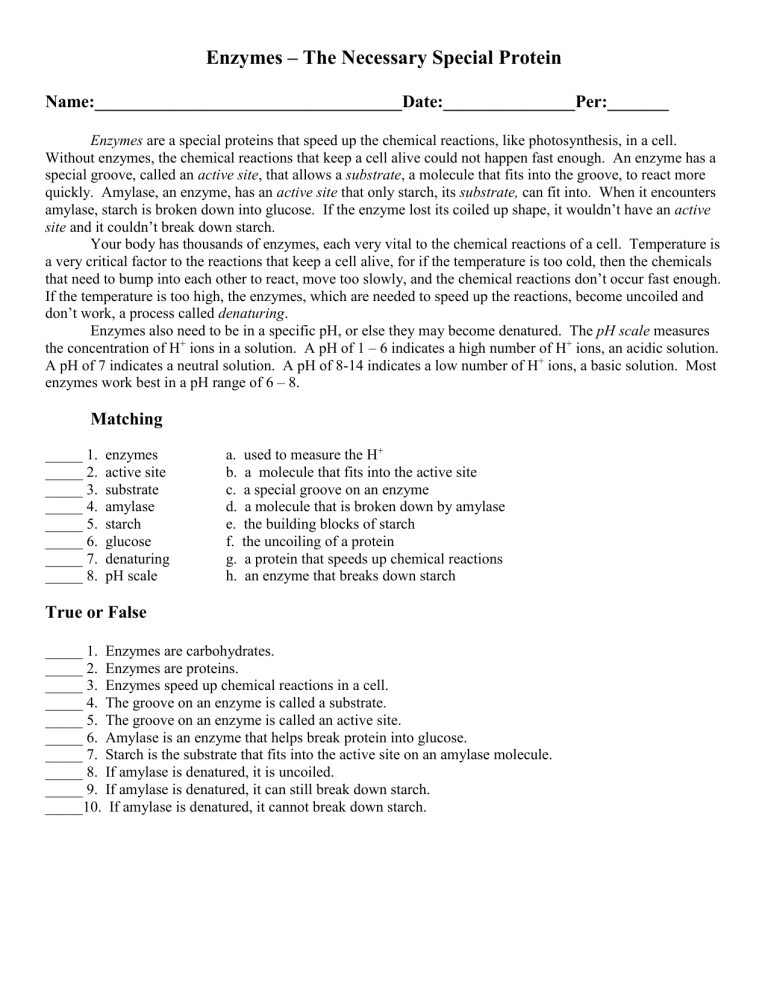
Enzymes – The Necessary Special Protein
Name:___________________________________Date:_______________Per:_______
Enzymes are a special proteins that speed up the chemical reactions, like photosynthesis, in a cell.
Without enzymes, the chemical reactions that keep a cell alive could not happen fast enough. An enzyme has a special groove, called an active site , that allows a substrate , a molecule that fits into the groove, to react more quickly. Amylase, an enzyme, has an active site that only starch, its substrate, can fit into. When it encounters amylase, starch is broken down into glucose. If the enzyme lost its coiled up shape, it wouldn’t have an active site and it couldn’t break down starch.
Your body has thousands of enzymes, each very vital to the chemical reactions of a cell. Temperature is a very critical factor to the reactions that keep a cell alive, for if the temperature is too cold, then the chemicals that need to bump into each other to react, move too slowly, and the chemical reactions don’t occur fast enough.
If the temperature is too high, the enzymes, which are needed to speed up the reactions, become uncoiled and don’t work, a process called denaturing .
Enzymes also need to be in a specific pH, or else they may become denatured. The pH scale measures the concentration of H
+
ions in a solution. A pH of 1 – 6 indicates a high number of H
+
ions, an acidic solution.
A pH of 7 indicates a neutral solution. A pH of 8-14 indicates a low number of H
+
ions, a basic solution. Most enzymes work best in a pH range of 6 – 8.
Matching
_____ 1. enzymes
_____ 2. active site
_____ 3. substrate
_____ 4. amylase
_____ 5. starch
_____ 6. glucose
_____ 7. denaturing
_____ 8. pH scale a. used to measure the H
+ b. a molecule that fits into the active site c. a special groove on an enzyme d. a molecule that is broken down by amylase e. the building blocks of starch f. the uncoiling of a protein g. a protein that speeds up chemical reactions h. an enzyme that breaks down starch
True or False
_____ 1. Enzymes are carbohydrates.
_____ 2. Enzymes are proteins.
_____ 3. Enzymes speed up chemical reactions in a cell.
_____ 4. The groove on an enzyme is called a substrate.
_____ 5. The groove on an enzyme is called an active site.
_____ 6. Amylase is an enzyme that helps break protein into glucose.
_____ 7. Starch is the substrate that fits into the active site on an amylase molecule.
_____ 8. If amylase is denatured, it is uncoiled.
_____ 9. If amylase is denatured, it can still break down starch.
_____10. If amylase is denatured, it cannot break down starch.
Completing Sentences enzyme substrate glucose chemical reactions amylase denatured active site starch
1. ____________________ is an enzyme that breaks down starch.
2. When starch attaches to the _________________ of an amylase molecule, the starch is broken into
______________.
3. The _________________ for amylase is starch.
4. An ________________ is a protein that speeds up chemical reactions in a cell.
5. If an amylase molecule becomes __________________, it will not be able to break
___________ down into glucose.
6. There are thousands of different enzymes that control the _______________________
within a cell.
True or False
_____ 1. Temperature is very important to the cell.
_____ 2. High temperatures cause the reactions in a cell to slow down too much.
_____ 3. High temperatures cause the enzymes in a cell to become denatured.
_____ 4. Cool temperatures do not affect the cell.
_____ 5. Cool temperatures make the chemical reactions to slow down too much.
_____ 6. The pH scale measures the strength of an acid or a base.
_____ 7. An acid is indicated by a pH level between 8 and 14.
_____ 8. An acid is indicated by a pH level between 1 and 6.
_____ 9. A neutral solution has a pH of 14.
_____ 10. Most enzymes work best in a pH of 1 to 3.
_____ 11. Most enzymes work best in a pH of 6 to 8.
_____ 12. An enzyme may become denatured if it is placed in an acid.
Completing Sentences – Words may be used more than once. pH scale high temperatures low temperatures denatured base uncoiled neutral acid
1. Enzymes are described as __________________ if they become uncoiled.
2. Enzymes may be denatured if they are exposed to _______ or __________________.
3. The ________________ is used to measure how acidic or basic a solution is.
4. A solution that has a pH between 1 and 6 is an ________.
5. A solution that has a pH of 7 is ______________.
6. A solution that has a pH between 8 and 14 is a ___________.
7. _______________________ cause the molecules to move too slowly to allow
chemical reactions to happen fast enough.


